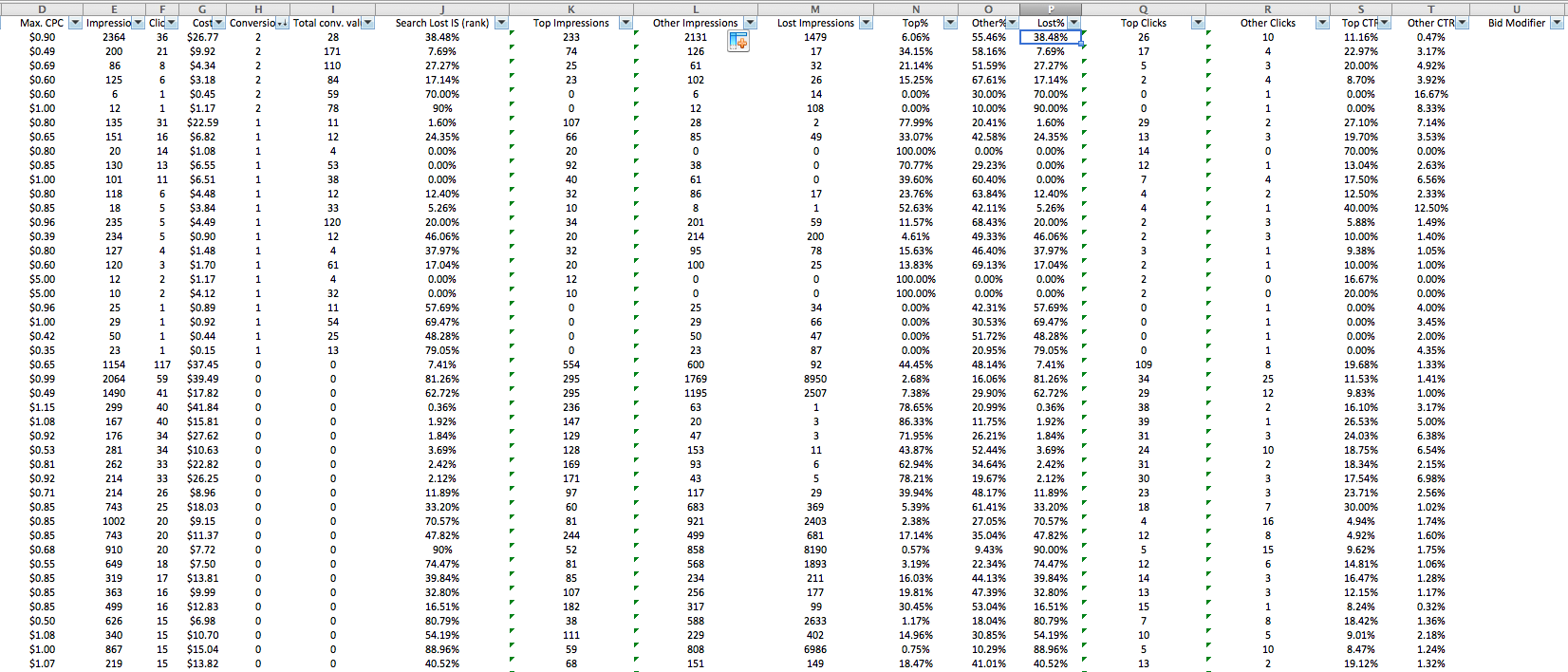Every month on the third Wednesday at Hanapin Marketing we have a training day where we each participate in running sessions to help train the team and keep the balance of knowledge in the industry across the company. This past Wednesday the team debated utilizing “Top vs Other” data rather than Average Position when making bid changes.
What’s Wrong with Average Position?
- It does not consider auctions where you are not showing at all (impression share due to rank)
- Some auctions position ads 1-3 on top of the page (above the organic listings), other auctions don’t show ads on top of the page
- On broad keywords, average position 3 could mean you typically show in position 3, OR your ad varies constantly between positions 1-8 depending on the query a user typed
It seems as though Average Position has been proven to be a misleading statistic for quite some time now. Alistar Dent from eConsultancy pointed this out in 2012, George Michie proved this point in 2013 via Search Engine Land, and I am sure plenty others have also come to the conclusion that average position isn’t perfect.
In my opinion average position is near perfect. So long as you have 100% impression share in an account where only exact match keywords are being used, and campaigns built out for very specific locations at specific times of the day. In this case your position should not vary too often, and average position could essentially show where your ad is typically showing in each auction.
So, what is the problem? Obviously, there are essentially no accounts built out this way, and in most cases (if not all) it would be a crazy decision to build an account this way. So, what happens to average position when you use broad match keywords with regular targeting? Let’s see an example as to what can happen when optimizing based on average position on broad or phrase match keywords:
Keyword: womens clothing
Search 1: “womens clothing at kohls”
This query was searched 100 times, and our ad showed in position eight 3 times and we did not show at all in the other 97 auctions due to rank.
Search 2: “womens clothes online”
This query was searched 100 times, and our ad showed in position two 50 times and position four 45 times. 5 times our ad did not show.
Search 3: “womens clothing”
This query was searched 100 times, and our ad showed in position one 90 times and position two 10 times
For simplicity we will say these are our only three terms connecting to this broad keyword. So, what is our average position?
Position One: 90 times
Position Two: 60 times
Position Four: 45 times
Position Eight: 3 Times
Average Position: 2.1
Our average position is 2.1 and performance is great, let’s slightly raise our bid to make sure our ad is in position one.
Search 1: “womens clothing at kohls”
This query was searched 100 times, and our ad showed in position eight 97 times and we did not show at all in the other 3 auctions due to rank.
Search 2: “womens clothes online”
This query was searched 100 times, and our ad showed in position one 50 times and position three 50 times.
Search 3: “womens clothing”
This query was searched 100 times, and our ad showed in position one 100 times
Position One: 150 times
Position Three: 50 times
Position Eight: 97 Times
Average Position: 3.6
Woah! What happened? How can I raise my bid and see a large increase in Average Position? Well, your impression share has now improved as you are entering auctions that you were not showing in previously through this keyword. Your automation process will read this as average position dropping, so we need to raise bids even farther. This could be the correct route to take (though adding more exact match keywords in this case would more than likely be the better route to take), but we do not have the true data to show if we should raise bids even further. We see an average position, we see a keyword meeting goals, we make the bid change.
What Is The Alternative?
As many articles have discussed, utilizing “Top vs Other” is the alternative that advertisers should be using rather than Average Position. So, why are we not doing it this way? Well, for one, download the top vs other performance and try to organize it in a manner where bid changes are possible to make in an efficient way. Very hard to do. Also – if you simply use top vs other aren’t you getting into a similar situation as utilizing Average Position? In the example above we’d be seeing:
Top: 150 impressions
Other: 48 impressions
Then after the bid change we’d be seeing something like:
Top: 200 impressions
Other: 97 impressions
How did so many more impressions end up in the “other”? As stated previously, this is because we are entering more auctions, and this is why the recommendation here is to use a three-position model:
- Top of the Page
- Other (Side or Bottom of the Page)
- Lost Impressions Due to Rank
Let’s review the previous example with this model:
Top: 150 impressions
Other: 48 impressions
Lost: 97 impressions
Then, the bid on the keyword was raised due to performance and we saw:
Top: 200 impressions
Other: 97 impressions
Lost: 3 impressions
Now, this makes more sense. We can visualize here that more ads are showing in positions where we would receive more clicks, and more ads are showing across the board due to the raising of bids. So, how can we get this data organized to actually make changes according to these numbers?
Well, it takes some time to get this type of data organized, and that is why the utilization of “Top vs Other” sometimes is avoided.
Here is the step by step process of how I retrieve the data I need:
Step One: Filter keywords by > 1 impression and download the entire keyword list
Step Two: Go to Segment > Top vs Other and download the keyword list once again
Step Three: Filter across all columns on the Top vs Other sheet
Step Four: If your campaign includes the Search Partner Network make 4 copies of the Top v Other data, if not then make 2 copies of the Top v Other data
Step Five: Filter each of the 4 copies by a different segment. Delete the other three segments on each sheet. (if you don’t utilize Search Partners do this for the two copies). You should now have a tab for Top of Google, Other of Google, Top of Search Partners, and Other of Search Partners.
Step Six: Copy all tabs into one document, so you have 5 total tabs. 1) regular keyword data, 2) top on google data, 3) other on google data, 4) top on search partners data, 5) other on search partner data
Step Seven: Utilize the excel formula:
=IF(ISNA(VLOOKUP(A:A,Top!B:G,6,FALSE)),0,VLOOKUP(A:A,TOP!B:G,6,FALSE))
This will get you the amount of impressions for the top of the page for each keyword in that line. Utilize this same formula for each tab. If you utilize Search Partners you can add Search Partner impression data with Google Search impression data in order to get a total “Top of Page Impression Amount” and “Other Impression Amount”. You can use the same type of formula for clicks, but you would use B:H and 7 respectively within the VLOOKUP formula to receive the click data.
Note: In this example data is organized on the top v other tabs: segmentation, keyword, campaign, ad group, status, max cpc, impressions, clicks, cost, conversion, revenue. While, keyword is the first column in the original raw keyword data sheet.
At the end of the day you should have something that looks like this with one keyword listed per line (rows A:C being keyword, campaign, and ad group data):
(Note: Lost impressions would be equal to: (impressions/(1-lost IS due to rank)*lost IS due to rank))
From here you can make a more educated decision on how you would want to change your bids and the effects it will have on your keywords performance in terms of bringing more impressions, bringing more impressions to the top of the page, or both when raising bids and vise versa when dropping bids. This allows for a simple copy and paste into the editor per usual when making manual bid changes as well.
Now, to create a formula to help automate this process a little bit once we have gotten this far. It’s in the works.





